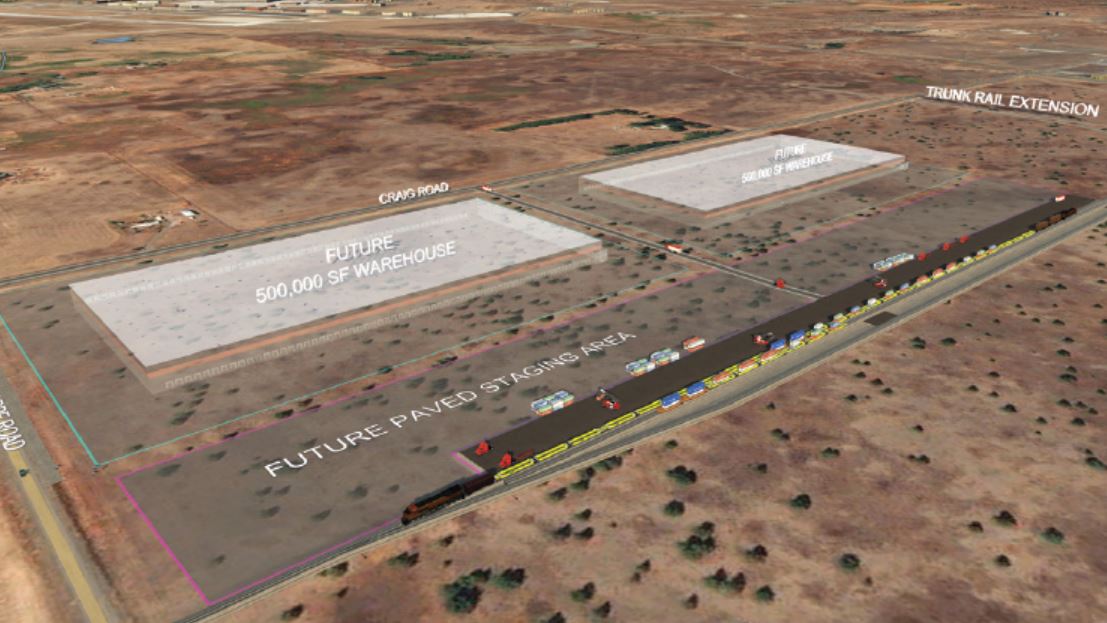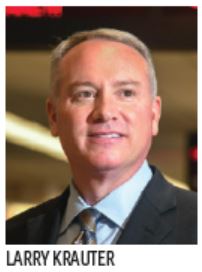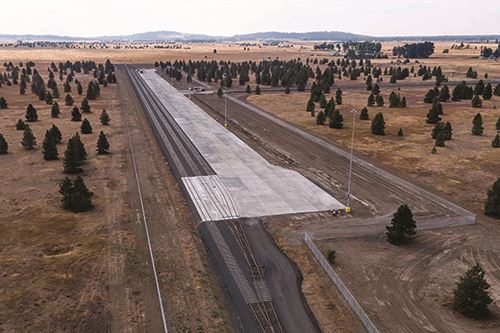Seattle is well known as the headquarters for Amazon, Starbucks and Alaska Airlines. But it’s Spokane, the second-largest city in Washington, that serves as the commercial, industrial and transportation hub for an approximately 80,000 square mile area over three U.S. states and two Canadian provinces.
Seattle is well known as the headquarters for Amazon, Starbucks and Alaska Airlines. But it’s Spokane, the second-largest city in Washington, that serves as the commercial, industrial and transportation hub for an approximately 80,000 square mile area over three U.S. states and two Canadian provinces. For instance, it anchors more than 100 aerospace suppliers that generate $1 billion in revenue and employ more than 8,000 workers. The city is also the home of Fairchild Air Force Base and a thriving railway freight system throughout the region.
For the past several years, Spokane International Airport (GEG) has been developing a new rail-truck transload facility to provide multimodal freight movement services to the area. Construction is substantially complete, and the new facility is expected to open later this year. Created to meet the needs of the growing region and allay congestion on nearby Interstate 90, the Transload Facility was possible because of a unique asset at GEG: surplus land.
Spanning about 4.3 acres of concrete circulation area alone, the new Transload Facility includes 1.7 miles of new track alignment, two loading tracks that are nearly a half-mile long each, plus several turnouts—all surrounded by a long running track. And there’s still plenty of room for expansion, with 500+ acres of surplus airport land east of the new facility and two adjacent 40-acre parcels on the west side available for sale or lease.
|
facts&figures Project: Rail-Truck Transload Facility Location: Spokane (WA) Int’l Airport Key Components: 182,560 sq. ft. concrete staging area; 2 loading tracks; 1 running track; 5 turnouts Cost: $14.3 million Funding: $11.3 million U.S. Dept. of Transportation BUILD grant; $2 million in airport funds; $1 million Consolidated Rail Infrastructure & Safety Improvements grant Timeline: Rail spur added in 2019; concrete & facility construction Sept. 2021-fall 2022 Grand Opening: Fall 2023 Project Management, Construction Management & Planning: KPFF Consulting Engineers
Construction Management
General Contractor:
Public Utility Design:
Geotechnical Engineering & Environmental Surveys: Key Goals/Benefits: Contributing to region’s economic health; lease revenues from surplus property will help fund future development projects |
Room for Growth
Before the world essentially shut down in 2020 due to the COVID pandemic, GEG had reached a record number of enplaned passengers in 2019—more than 2 million. The airport has steady airline traffic with passenger service by Alaska, Allegiant, American, Delta, Southwest and United; plus active cargo activity from FedEx, UPS and Amazon’s Prime Air. By the end of 2022, passenger numbers had nearly returned to 2019 levels. Cargo numbers took a slight dip between 2018 and 2019, but then started growing. And growing. And growing.
These days, GEG is quickly approaching 80,000 tons of cargo per year. Fortunately, airport officials foresaw the need for a multimodal facility long before this latest growth surge. When Chief Executive Officer Larry Krauter came to the airport in 2011, evaluating the idea of a transload facility was already a few years in process. The state of Washington had commissioned preliminary research to determine if a rail-truck facility should be built on a county-owned spur line located about seven miles from a major BNSF rail line.
Encouraged by the results, Krauter and his team began a strategic plan to develop the airport’s surplus property and determine the infrastructure needed to support a multimodal center. The prime prospects for users were logistics, advanced manufacturing and aerospace businesses.
“The studies had evaluated four sites, but what was interesting to me was that none of them were at the airport,” Krauter relates. “All of them were terribly constrained, each from eight to 28 acres in size. My idea was to bring a bigger vision for integrating the transport modes.”
The project team recognized that GEG had several significant assets: about 6,400 acres of land, proximity to Fairchild Air Force Base and access to I-90 via four interchanges. Its unique combination of commercial air service, a nearby rail line, excellent highway access and lots of available property added up to a big potential win.
KPFF Consulting Engineers got involved with the project in 2018 when GEG hired it to design the trunk rail extension, a grant-funded section of track near the airport’s property. KPFF Principal Steve Kingsley says that most of the firm’s railway projects have been with marine ports because it’s unusual for airports to embark upon this type of endeavor. When plans for the trunk rail extension were in place, the airport contracted KPFF to develop a proposal about how to develop a world-class transload facility on its surplus property located near the county-owned spur.
 “We created a master plan to guide the airport’s decision-making for development,” Kingsley explains. “Shortly after that, we competed to win the second phase of the transload project, comprising three initial tracks, cargo handling and truck circulation. Part of the proposal included a functional place for trains to unload and for trucks to transfer their loads to the trains.”
“We created a master plan to guide the airport’s decision-making for development,” Kingsley explains. “Shortly after that, we competed to win the second phase of the transload project, comprising three initial tracks, cargo handling and truck circulation. Part of the proposal included a functional place for trains to unload and for trucks to transfer their loads to the trains.”
Krauter and his team liked what they saw and began building support with local, state and federal officials and related agencies to put the proposed facility on airport land. “If you look at what the state and county were trying to do before the airport got engaged, the sites were very limited,” he reasons. “Here, the space is unlimited. We can meet any demands that need to be serviced in the future, and that’s what makes it special. We have the ability to expand, including the ability to assemble unit trains, which are favored by a lot of the rail operators.”
Unit trains transport one type of freight in one type of car to a single destination, so they are allowed to bypass intermediary rail yards and run directly from point to point. This special type of train can include more than 90 rail cars.
Once GEG secured the green light to proceed with the project on airport land, the administration team needed a good project manager to help bring it all together. Lisa Corcoran, director of Planning and Development, recruited Colin Hayden for the role in 2021. Hayden had previously worked for a seaport in Washington and also had experience in the rail industry, which was helpful for project planning and execution.
“We had incredible synergy, because Colin already knew how to run these kinds of projects,” Krauter remarks.
Not Your Father’s Concrete
With Hayden on board, the project team employed some novel strategies. The most notable was using roller-compacted concrete for nearly 200,000 square feet of staging area.
This specialty material contains the same basic ingredients as conventional concrete—cement, water and aggregate materials—but is a drier mix and doesn’t require steel reinforcing bars. At the transload construction site, crews mix roller-compacted concrete and loaded it into a paver to form an 8-inch-thick mat. Construction-grade rollers followed the paver, and within an hour, another 8-inch mat was laid. Layer by layer, contractors created 16-inch-thick pavement.
 Krauter reports that using roller-compacted concrete saved the airport 40% over conventional concrete. Moreover, installation took less than half the time because it cures much faster. “It was interesting, because roller-compacted concrete hasn’t been used much in this part of the world,” he says. “We bid the project both ways, and the roller-compacted concrete was more attractive than sticking with the traditional concrete placement process. A lot of people came out to watch what was going on, because this has great applications for other projects in our community. It was amazing how much time and cost savings it afforded us.”
Krauter reports that using roller-compacted concrete saved the airport 40% over conventional concrete. Moreover, installation took less than half the time because it cures much faster. “It was interesting, because roller-compacted concrete hasn’t been used much in this part of the world,” he says. “We bid the project both ways, and the roller-compacted concrete was more attractive than sticking with the traditional concrete placement process. A lot of people came out to watch what was going on, because this has great applications for other projects in our community. It was amazing how much time and cost savings it afforded us.”
He also notes that the roller-compacted concrete provides an exceptional working surface, even with Spokane’s frequent snow and ice. From an aesthetic perspective, the mat surpassed Kingsley’s expectations, and Hayden describes it as strong and stable. Because roller-compacted concrete doesn’t require rebar, it eliminated the labor needed to lay steel.
“The biggest challenge was definitely the pavement,” Kingsley reflects. “One of the key things we did that made this financially viable and possible within the plan was to use this alternative pavement process. The decision to do that helped the airport realize cost savings, but it required us to find a contractor with experience laying roller-compacted concrete. There were quite a few challenges with the schedule, but it enabled us to meet the budget and timeline.”

The Business Case
The vast majority of the $14.3 million project was funded with an $11.3 million BUILD grant (Better Utilizing Investments to Leverage Development) from the U.S. Department of Transportation. The airport also spent $2 million of its own revenue and received $1 million from the Consolidated Rail Infrastructure and Safety Improvements (CRISI) program, a Transportation Department initiative that helps fund capital projects to improve the safety, efficiency or reliability of passenger and freight rail systems. Since then, even more funding has become available for improvements.
 “We were already making plans for improvement and recently received an additional $1.5 million in congressional-directed funding from Senator Cantwell for constructing crossings for vehicle and loading equipment,” Krauter says. “We also received money from the state legislature transportation capital budget to build a dedicated liquids line that will be state-of-the-art in terms of its environmental safety design element. This will provide full containment, which allows us to handle any kind of liquid, including volatiles.”
“We were already making plans for improvement and recently received an additional $1.5 million in congressional-directed funding from Senator Cantwell for constructing crossings for vehicle and loading equipment,” Krauter says. “We also received money from the state legislature transportation capital budget to build a dedicated liquids line that will be state-of-the-art in terms of its environmental safety design element. This will provide full containment, which allows us to handle any kind of liquid, including volatiles.”
Contractors appreciated working on a greenfield site located on the far western edge of airport property. Because the jobsite was fully two miles from the airfield, crews could work without disruptions from flight operations and didn’t need special security credentials.
Krauter reports that the entire project team was excited about delivering a key piece of infrastructure for the region and establishing a line of business for the airport that didn’t previously exist. “The other opportunity is to use the transload facility to leverage a sale or lease of surplus property at appreciably better price points as well as to leverage the facility to support job creation, all of which comes back to the airport in additional demand for air service as well as additional revenue to invest in capital projects,” he adds. “All of that was just executing the totality of our vision.”
Looking ahead, Krauter foresees increased regional growth and expansion because the new Transload Facility will help attract more companies to the area.
“We had something like 15 companies write letters of support for our grant application,” he says. “From our perspective, the value of what this project has done for our property is significant, and we can sell property to fund capital improvements we need going forward. It’s a positive development and illustrates that the airport and our Board are very entrepreneurial. And it’s exciting to deliver on a strategic multimodal infrastructure priority that had been thought about for many years by the community.”



